Bonjour Tout le Monde,
I am writing to you from Paris, France. Both of my plane flights went relatively well. I was able to catch up on some reading and watch a few movies while in the air. When I arrived in France, I took a train from the airport to my hotel. Luckily they both had stops on the same line. However, when I tried to leave the train station, I discovered that I had accidentally purchased the wrong ticket and therefore the turn-styles would not let me exit the station. In order to leave, I ended up calling the ticket office at the train station for help and one of the workers just manually opened the gate for me.
The classes for the French summer language intensive program seem to be going pretty well. We start at 9:00 am and finish by 4:00 pm on most days with about a two hour lunch break from 12:00 pm to 2:00 pm. We work a lot of building vocabulary and verb conjugation. When classes finish for the day, I either go to the supermarket to buy food or take the train into Paris for sightseeing.
The most iconic symbol and tourist attraction is, of course, the Eiffel Tower. According to the website for the landmark, the Eiffel Tower was built to commemorate the Exposition Universelle in 1889 which celebrated the 100th anniversary of the French Revolution. The tower was designed by Gustave Eiffel and took two years and two months to build.
Besides having 1,665 steps to the top, the Eiffel Tower is also known to light up every night for the first five minutes of every hour.
In the picture with me are some of my classmates from the French summer language intensive program. Students come from countries all over the world, such as Brazil, Russia, Spain, South Africa, and Australia.
Another must see landmark of Paris is the Notre Dame. This year marks the 850th anniversary since the start of construction of the cathedral in 1163. Notre Dame then took about 100 years to complete.
The cathedral has about 37 sculptures of Mary, the Mother of God, inside the building and on the outside. Notre Dame is also known for having beautiful stained glass windows. The grandest of the windows is the South Rose Window, which was constructed in 1258 and has a diameter of 12.90 meters and a height of almost 19 meters. The 84 panes are divided into four circles each displaying events in the New Testament.
During one of my free afternoons, a few of my classmates and I visited Bercy Park, which is located in the eastern side of Paris. Of the parks that I have visited in the past week, this one is by far my favorite because it contains many beautiful garden and flower beds, mazes, ponds with bridges, arched walkways, and statues. Here are just a few pictures of the park:

This tree lined walk way contained many benches suitable for reading books, eating a meal, or spending time in the presence of others. Taken in July of 2013.
Bercy Park really highlighted one of the differences between French and American culture. I have noticed that the French have no hesitation to publicly display affection. While in America it is common to see couples holding hands and maybe exchanging a quick peck on the lips, the amount of touching between couples seems toned down compared to French couples. French couples, young and old, don’t mind making out in parks, trains, dance clubs, and other areas where everyone else can see them too. In addition, even on trains or walking on the street, it seems that the French have a much smaller personal space bubble than people in the US. It is very interesting and something that I need to learn to adapt to since I tend have a bubble larger than most of the French.
During this weekend, one of my classmates, Irina, and I visited the Ménangerie du Jardin des Plantes, essentially a small zoo located in the middle of Paris. Even though the menagerie was smaller than most zoos in the US, there were still plenty of animals to look at and learn about. Irina and I practiced our French by reading the information signs located next to each exhibit. One thing that I noticed was that each exhibit had smaller walls and fences compared to enclosures in the US. This may be due to the fact that since the menagerie was smaller, it did not contain many of the larger, more dangerous animals and therefore needed smaller safety precautions. It is also possible that France has fewer and less strict rules than in the US. Either way, it allowed Irina and me to view animals up close. Even though the menagerie was small, we were still able to see a lot of animals.
One of the other must-dos in Paris is to experience the Parisian night life. On Saturday night, a few of my classmates and I went to a discothèque, a dance club. The one we visited was called Mix-Club whose entrance was located on street level, but whose dance floor was actually a few stories underground. The music was very loud and from countries all over the world. In addition, there were also a lot of flashing lights and fog machines. Since I love to dance, I thoroughly enjoyed myself. Even though we stayed at the club until 5AM, the club was nowhere near close to closing. The idea in Paris is that night clubs stay open until morning so that many intoxicated dancers have access to public transportation such as the trains, busses, and metro, most of which are closed at night, and to decrease the amount of drunk driving and related accidents. It makes sense to me. Since the other clubs in the same area are also underground, noise isn’t much of a problem, the clubs make more money, and people are kept safer.
Thank you for reading,
-Brenna



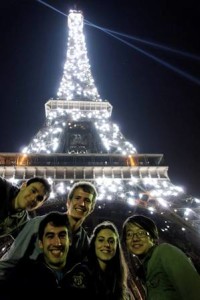







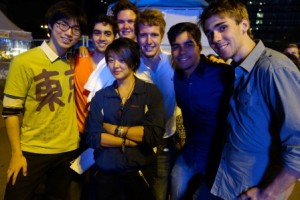
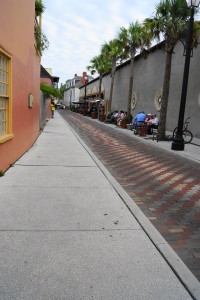
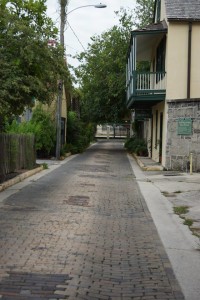
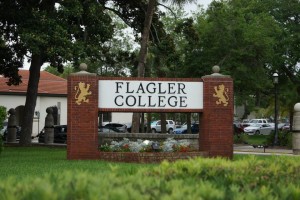
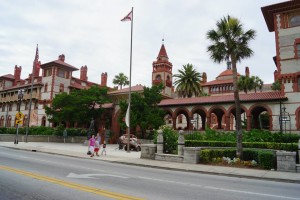
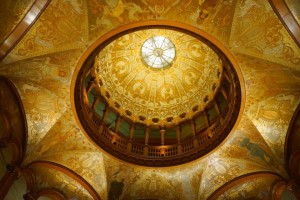
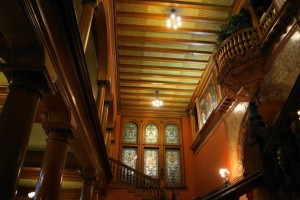

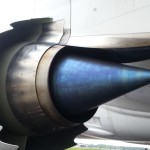
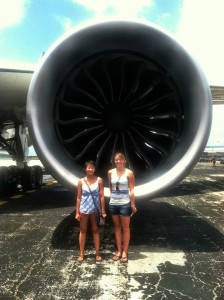
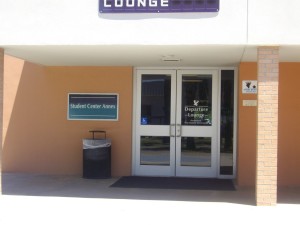

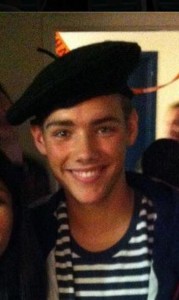


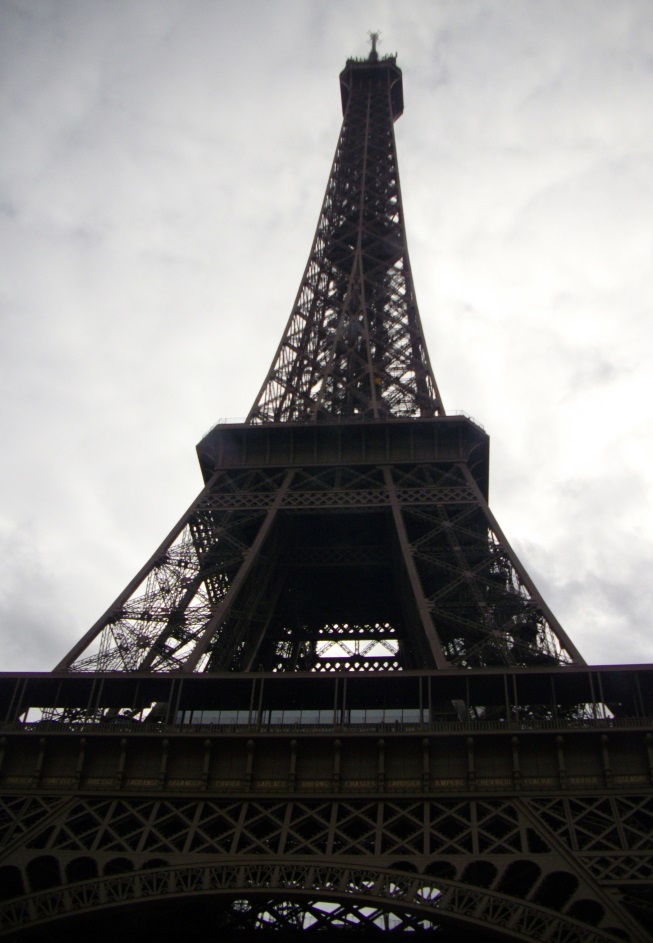
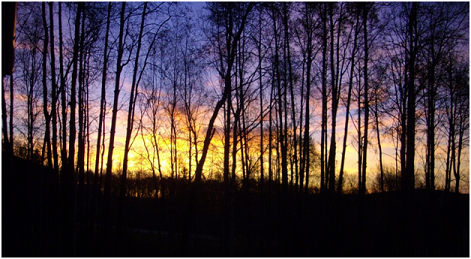 I took this picture from my front porch. This October sunset is just one of the many beautiful views of Alaska.
I took this picture from my front porch. This October sunset is just one of the many beautiful views of Alaska. 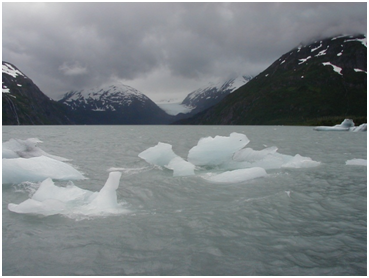 This is a picture of a few ice floes in one of the sounds.
This is a picture of a few ice floes in one of the sounds. 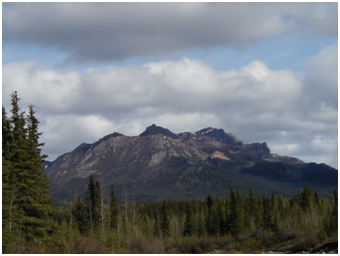 This is one of Alaska’s many mountains.
This is one of Alaska’s many mountains. 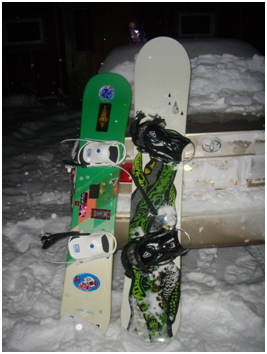 My snowboard standing next to my friend’s board – he’s very tall and I’m short. Some of my friends also enjoy snow machining or four wheeling depending on the season.
My snowboard standing next to my friend’s board – he’s very tall and I’m short. Some of my friends also enjoy snow machining or four wheeling depending on the season.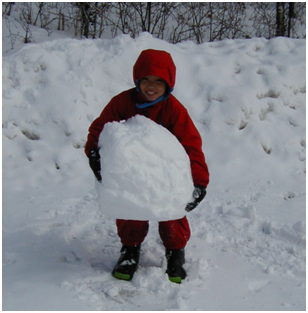 This is a picture of me when I was about 5 or six years old. I’m demonstrating proper winter attire while carrying the head for my snowman. The road is not paved and we don’t have a well or city water. As a result, we have a holding tank that a water truck fills every few weeks. However, we do have electricity and internet, both for which I am thankful.
This is a picture of me when I was about 5 or six years old. I’m demonstrating proper winter attire while carrying the head for my snowman. The road is not paved and we don’t have a well or city water. As a result, we have a holding tank that a water truck fills every few weeks. However, we do have electricity and internet, both for which I am thankful.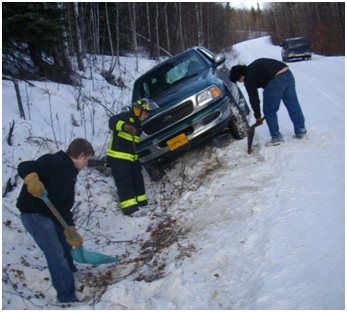 My truck slid into a ditch due to icy roads. Thank you to my friends who helped me to dig it out.Every year people die due to the cold and not dressing warmly enough. Sometimes, moose wander across roads or into lawns, causing car accidents or threatening the safety of people and pets in yards. In the summer, people like to go camping. If they are unprepared, they risk being visited by a hungry grizzly bear. However, as long as people know what to do, such as staying away from moose and not keeping food at their campsite, most of the time they should be fine.
My truck slid into a ditch due to icy roads. Thank you to my friends who helped me to dig it out.Every year people die due to the cold and not dressing warmly enough. Sometimes, moose wander across roads or into lawns, causing car accidents or threatening the safety of people and pets in yards. In the summer, people like to go camping. If they are unprepared, they risk being visited by a hungry grizzly bear. However, as long as people know what to do, such as staying away from moose and not keeping food at their campsite, most of the time they should be fine.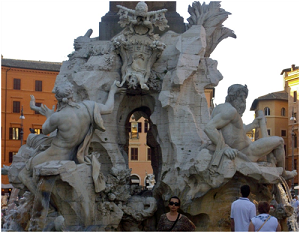 On the way to the restaurant, we passed a number of historical sites, such as The Fountain of Four Rivers.
On the way to the restaurant, we passed a number of historical sites, such as The Fountain of Four Rivers. Located in Piazza Navona, the work of art was designed by Gian Lorenzo Bernini in 1651 for Pope Innocent X. Bernini’s work symbolizes the four rivers, the Nile, Danube, Ganges, and Platte, whose continents, Europe, Asia, Africa, and the Americas, throughout which the papal authority had spread. The papal symbol, the two crossed keys, with the crest of the pope can be seen over the arch of the fountain. On top of the combination of architecture and sculpture, there is an Egyptian obelisk.
Located in Piazza Navona, the work of art was designed by Gian Lorenzo Bernini in 1651 for Pope Innocent X. Bernini’s work symbolizes the four rivers, the Nile, Danube, Ganges, and Platte, whose continents, Europe, Asia, Africa, and the Americas, throughout which the papal authority had spread. The papal symbol, the two crossed keys, with the crest of the pope can be seen over the arch of the fountain. On top of the combination of architecture and sculpture, there is an Egyptian obelisk.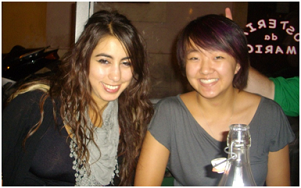 We ate dinner at a small restaurant with outdoor seating. I splurged and ordered a pasta alla carbonara. The dish was made up of pasta, egg, cheese, and bacon. Everybody agreed it was one of the best dishes of the night. While we were waiting for our meal, we took the opportunity to smile for a few photos.
We ate dinner at a small restaurant with outdoor seating. I splurged and ordered a pasta alla carbonara. The dish was made up of pasta, egg, cheese, and bacon. Everybody agreed it was one of the best dishes of the night. While we were waiting for our meal, we took the opportunity to smile for a few photos.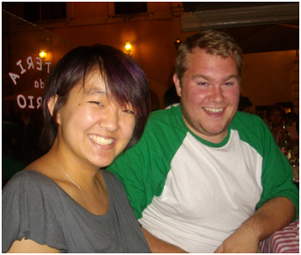 Even though Candace is a few years older than me we got along great. She’s from the ERAU campus in Prescott, Arizona and just graduated with a bachelor’s degree in electrical engineering. Candace is pretty funny and we like a lot of the same things. I was fortunate that she chose to room with me. Oh, and before I forget, the alien antenna is courtesy of Charles. He has a crazy sense of humor, but can also be very pragmatic. Currently he’s studying aeronautical science at the Daytona Beach campus.
Even though Candace is a few years older than me we got along great. She’s from the ERAU campus in Prescott, Arizona and just graduated with a bachelor’s degree in electrical engineering. Candace is pretty funny and we like a lot of the same things. I was fortunate that she chose to room with me. Oh, and before I forget, the alien antenna is courtesy of Charles. He has a crazy sense of humor, but can also be very pragmatic. Currently he’s studying aeronautical science at the Daytona Beach campus.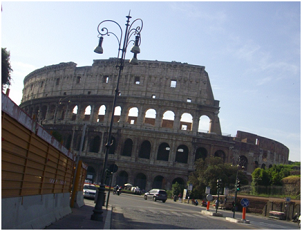 The next morning we started out bright and early. The first ancient building that we visited was the Colosseum.
The next morning we started out bright and early. The first ancient building that we visited was the Colosseum.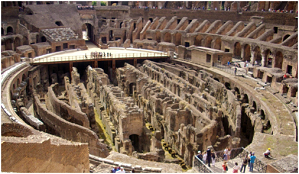 animals, in these public entertainments were housed in the hypogeum, a series of tunnels and cages underneath the floor of the main arena. In addition, there also used to be underground passages that connected the Colosseum to Ludus Magnus, a school where gladiators trained.
animals, in these public entertainments were housed in the hypogeum, a series of tunnels and cages underneath the floor of the main arena. In addition, there also used to be underground passages that connected the Colosseum to Ludus Magnus, a school where gladiators trained.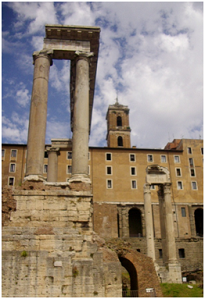
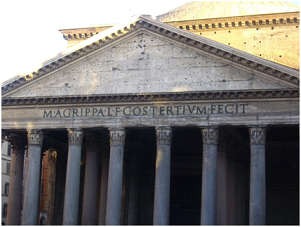
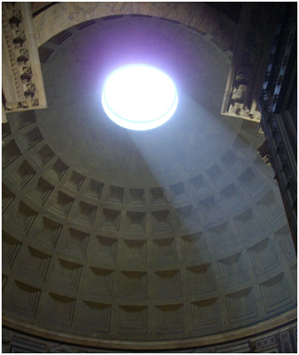
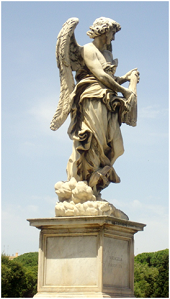
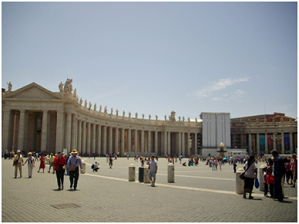 Eventually, we reached the Vatican. Vatican City is the smallest independent state in the world. It is here that the Pope, Pope Benedict XVI, lives. He is not only the Bishop of Rome, but also the head of the Catholic Church. One of the main entrances into the Vatican is St. Peter’s Square.
Eventually, we reached the Vatican. Vatican City is the smallest independent state in the world. It is here that the Pope, Pope Benedict XVI, lives. He is not only the Bishop of Rome, but also the head of the Catholic Church. One of the main entrances into the Vatican is St. Peter’s Square.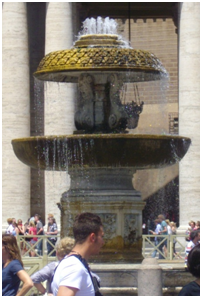
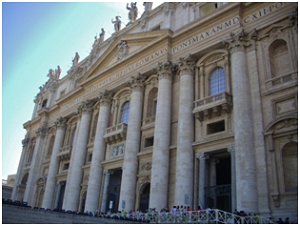 did not allow pictures. We saw Raphael’s School of Athens, which is a fresco depicting almost every great Greek philosopher. We were also able to visit the Sistine Chapel and see Michelangelo’s famous fresco on the ceiling. One of the many stories featured in the work of art is the story of Adam and Eve. The panel illustrating The Creation of Adam shows God reaching out to touch fingers with Adam. God appears to be reaching out of a human brain to perform this action, displaying Michelangelo’s knowledge of human anatomy. This gives evidence to the thought that the great Renaissance artist performed human autopsies even though they were illegal at the time.
did not allow pictures. We saw Raphael’s School of Athens, which is a fresco depicting almost every great Greek philosopher. We were also able to visit the Sistine Chapel and see Michelangelo’s famous fresco on the ceiling. One of the many stories featured in the work of art is the story of Adam and Eve. The panel illustrating The Creation of Adam shows God reaching out to touch fingers with Adam. God appears to be reaching out of a human brain to perform this action, displaying Michelangelo’s knowledge of human anatomy. This gives evidence to the thought that the great Renaissance artist performed human autopsies even though they were illegal at the time.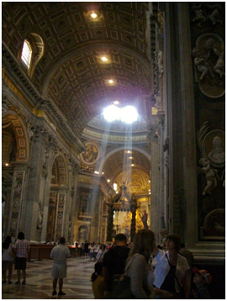 After spending hours in the Vatican Museum, and getting lost multiple times, we exited the building and entered St. Peter’s Basilica.
After spending hours in the Vatican Museum, and getting lost multiple times, we exited the building and entered St. Peter’s Basilica.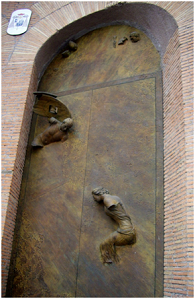 Following our visit to the Vatican, we returned to the refurbished monastery and recovered from the twelve hours of walking and incredible heat and humidity. While resting in my room, I contacted my friend John who is stationed in Naples with the Navy. I first met John four years ago on a People to People trip to the United Kingdom and Ireland. We kept in contact over the years and he was ecstatic to find out that I would be in Italy. He decided to come and visit while I was in Rome. That evening, a group of my fellow students and I met John and his friend at the Rome Hard Rock Café. We ate and talked the night away. After saying goodbye to John and leaving the restaurant, we decided to use the Roman metro system because we thought it would be an easier way to get back to the monastery. Unfortunately, certain subway lines only run until about 10 PM. While we’re not exactly sure how, we ended up on the back side of the Vatican, which was off our map. Eventually after walking around for about an hour to an hour and a half, we found our way back to the residence.
Following our visit to the Vatican, we returned to the refurbished monastery and recovered from the twelve hours of walking and incredible heat and humidity. While resting in my room, I contacted my friend John who is stationed in Naples with the Navy. I first met John four years ago on a People to People trip to the United Kingdom and Ireland. We kept in contact over the years and he was ecstatic to find out that I would be in Italy. He decided to come and visit while I was in Rome. That evening, a group of my fellow students and I met John and his friend at the Rome Hard Rock Café. We ate and talked the night away. After saying goodbye to John and leaving the restaurant, we decided to use the Roman metro system because we thought it would be an easier way to get back to the monastery. Unfortunately, certain subway lines only run until about 10 PM. While we’re not exactly sure how, we ended up on the back side of the Vatican, which was off our map. Eventually after walking around for about an hour to an hour and a half, we found our way back to the residence.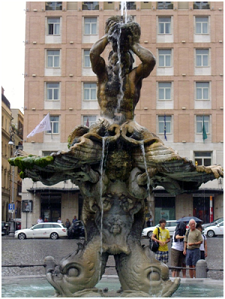 During the morning of our last day in Rome, the first place we visited was the Baths of Diocletian.
During the morning of our last day in Rome, the first place we visited was the Baths of Diocletian.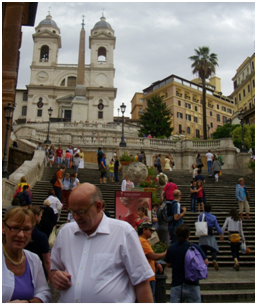 The last tourist attraction we visited as a group with our professors was the Spanish Steps.
The last tourist attraction we visited as a group with our professors was the Spanish Steps.
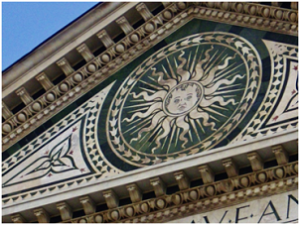
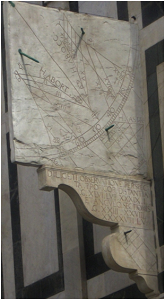 In the past, people used this decoration as a tool to tell then when important seasons and holidays were occuring based on the location of the shadows cast by the pins on the chart. In additon, Basilica of Santa Maria Novella is the first church to have volutes, or scrolls, located on either side of the pediment. These s-shaped decorations can be found on churches all over Italy and later were an important feature of Baroque architecture.
In the past, people used this decoration as a tool to tell then when important seasons and holidays were occuring based on the location of the shadows cast by the pins on the chart. In additon, Basilica of Santa Maria Novella is the first church to have volutes, or scrolls, located on either side of the pediment. These s-shaped decorations can be found on churches all over Italy and later were an important feature of Baroque architecture.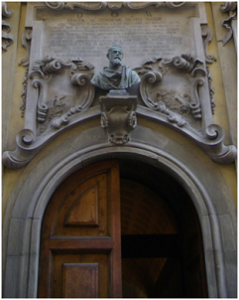 While we walked around Florence, we saw multiple busts of Galileo.
While we walked around Florence, we saw multiple busts of Galileo.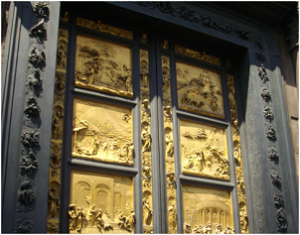 next destination was Lorenzo Ghiberti’s Gates of Paradise.
next destination was Lorenzo Ghiberti’s Gates of Paradise.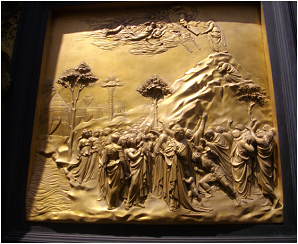 he Old Testament.
he Old Testament.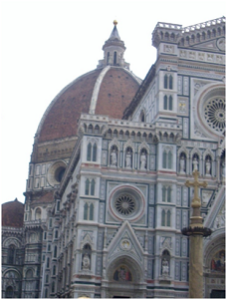
 attraction in Florence was two hours. Around midday, we entered the Uffizi Museum.
attraction in Florence was two hours. Around midday, we entered the Uffizi Museum.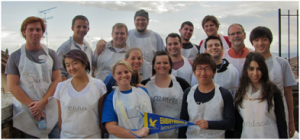
 Here are some students getting ready to eat. Picture courtesy of Bonnie Pratt. In the above picture, the blond woman is Dr. Pratt’s wife, Bonnie. She’s really nice and a favorite of the students. She enjoyed our meal. The noodles we made were by far the best noodles I have had while in Italy so far. Our meal lasted until around 10 PM at which we returned to our residence and went to bed in preparation for Luca’s class the next day.
Here are some students getting ready to eat. Picture courtesy of Bonnie Pratt. In the above picture, the blond woman is Dr. Pratt’s wife, Bonnie. She’s really nice and a favorite of the students. She enjoyed our meal. The noodles we made were by far the best noodles I have had while in Italy so far. Our meal lasted until around 10 PM at which we returned to our residence and went to bed in preparation for Luca’s class the next day.
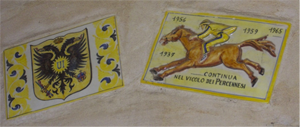 The stable of the Eagle contrada. The racetrack goes around the Piazza del Campo, the Siena’s city center. The race circles the Campo three times and typically lasts less than two minutes. Sometimes the goal of the jockeys is to keep the rival contrada from winning and sometimes jockeys are thrown from their horse. Luckily, the winner of the Palio is the first horse that crosses the finish line, not the rider. The loser of the race is considered to be the horse that came in second, not last. This is because the second place horse came so close to winning but failed to do so. We had multiple classes that taught us about the contrade and the Palio. Another part of our classes consisted of visiting different cities in Italy.
The stable of the Eagle contrada. The racetrack goes around the Piazza del Campo, the Siena’s city center. The race circles the Campo three times and typically lasts less than two minutes. Sometimes the goal of the jockeys is to keep the rival contrada from winning and sometimes jockeys are thrown from their horse. Luckily, the winner of the Palio is the first horse that crosses the finish line, not the rider. The loser of the race is considered to be the horse that came in second, not last. This is because the second place horse came so close to winning but failed to do so. We had multiple classes that taught us about the contrade and the Palio. Another part of our classes consisted of visiting different cities in Italy.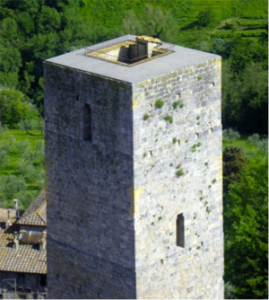 One of San Gimignano’s remaining towers. At one point in time, the city had as many as seventy two towers. The largest of these were around fifty meters tall. It is thought that affluent families would have towers built to show their wealth and supremacy. Currently, however, there are only fourteen towers still standing. The others were taken down due to wear, rebuilding, and wars. In the past, whenever a city was captured, the conquerors would knock down the town’s tower to symbolize the loss of power. During our trip to the city, we took the time to climb up San Gimignano’s tallest tower in order to view the beautiful Tuscan landscape. We could see the rolling hills, neighboring towns, vineyards, and rows upon rows of olive trees.
One of San Gimignano’s remaining towers. At one point in time, the city had as many as seventy two towers. The largest of these were around fifty meters tall. It is thought that affluent families would have towers built to show their wealth and supremacy. Currently, however, there are only fourteen towers still standing. The others were taken down due to wear, rebuilding, and wars. In the past, whenever a city was captured, the conquerors would knock down the town’s tower to symbolize the loss of power. During our trip to the city, we took the time to climb up San Gimignano’s tallest tower in order to view the beautiful Tuscan landscape. We could see the rolling hills, neighboring towns, vineyards, and rows upon rows of olive trees.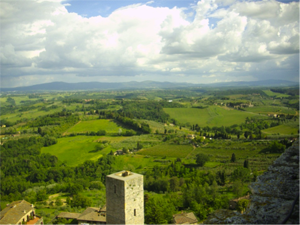 A view of Tuscany from the tallest tower of San Gimignano. Later that same week, we visited Venice. The city is built on top of 118 small islands that are connected by bridges and canals. The city, and the lagoon it rests in, is considered a World Heritage Site.
A view of Tuscany from the tallest tower of San Gimignano. Later that same week, we visited Venice. The city is built on top of 118 small islands that are connected by bridges and canals. The city, and the lagoon it rests in, is considered a World Heritage Site.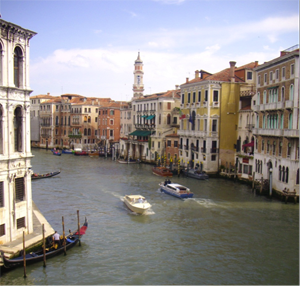 The Grand Canal, one of the main waterways of the city. This picture was taken from the Scalzi Bridge. During the Middle Ages and the Renaissance, Venice was a major maritime power and an important center of commerce due to the city’s location directly on the water. Furthermore, the metropolis was also the origin of many important artistic movements and styles, such as the Renaissance and the Venetian School. Presently, this town is very famous for its Venetian glass and the Carnival of Venice, which is when people wear intricate and beautiful masks.
The Grand Canal, one of the main waterways of the city. This picture was taken from the Scalzi Bridge. During the Middle Ages and the Renaissance, Venice was a major maritime power and an important center of commerce due to the city’s location directly on the water. Furthermore, the metropolis was also the origin of many important artistic movements and styles, such as the Renaissance and the Venetian School. Presently, this town is very famous for its Venetian glass and the Carnival of Venice, which is when people wear intricate and beautiful masks.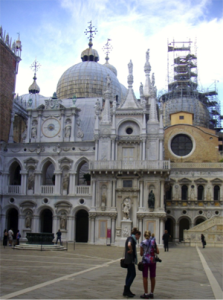 This is a view from the inner courtyard of the Doge’s Palace. My favorite exhibit in the museum was about medieval warfare. The display had many artifacts and was quite expansive. There were full suits of armor for people and horses, swords, daggers, crossbows, guns, spears, and so much more. Since my father loves knights, I grew up adoring castles and watching films about the Middle Ages. I was very disappointed to find out that I was not allowed to take pictures of the collection. I must have spent up to two hours in the museum.
This is a view from the inner courtyard of the Doge’s Palace. My favorite exhibit in the museum was about medieval warfare. The display had many artifacts and was quite expansive. There were full suits of armor for people and horses, swords, daggers, crossbows, guns, spears, and so much more. Since my father loves knights, I grew up adoring castles and watching films about the Middle Ages. I was very disappointed to find out that I was not allowed to take pictures of the collection. I must have spent up to two hours in the museum.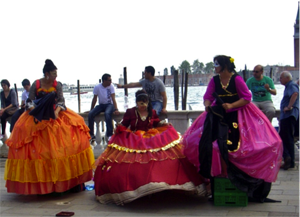 Three people putting on their Carnival of Venice costumes. When I was walking around Venice from island to island across the bridges, I noticed that some of the crossings had locks attached to them. These locks usually had two names written on them and the date of when the lock was placed on the bridge. Sometimes there were even inscriptions about love lasting forever, giving them the name “love locks”.
Three people putting on their Carnival of Venice costumes. When I was walking around Venice from island to island across the bridges, I noticed that some of the crossings had locks attached to them. These locks usually had two names written on them and the date of when the lock was placed on the bridge. Sometimes there were even inscriptions about love lasting forever, giving them the name “love locks”.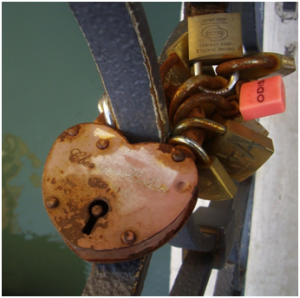 Some of the many love locks that I saw attached bridges. The idea behind the love locks is that two sweethearts engrave their names onto a padlock and attach it to a public fixture such as a bridge, gate, fence, etc. and throw away the key. Since the lock cannot ever be removed, this symbolizes their undying love for each other. While an appealing idea, these love locks are considered to be controversial. Some people do not like them because they build up over time and can affect the aesthetic quality of public places.
Some of the many love locks that I saw attached bridges. The idea behind the love locks is that two sweethearts engrave their names onto a padlock and attach it to a public fixture such as a bridge, gate, fence, etc. and throw away the key. Since the lock cannot ever be removed, this symbolizes their undying love for each other. While an appealing idea, these love locks are considered to be controversial. Some people do not like them because they build up over time and can affect the aesthetic quality of public places.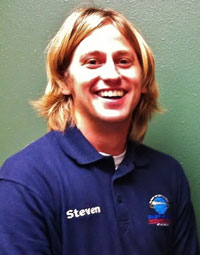 Before I get started about my travels to Siena, Italy and my experiences, I have one order of business to take care of. My previous entry mentioned Steven Bohlemann, a student who works in the Study Abroad Office, but I was not able to get a picture of him in time before I turned the journal admission. As promised, here is a picture of Steven (courtesy of the Study Abroad Office in Daytona Beach).
Before I get started about my travels to Siena, Italy and my experiences, I have one order of business to take care of. My previous entry mentioned Steven Bohlemann, a student who works in the Study Abroad Office, but I was not able to get a picture of him in time before I turned the journal admission. As promised, here is a picture of Steven (courtesy of the Study Abroad Office in Daytona Beach).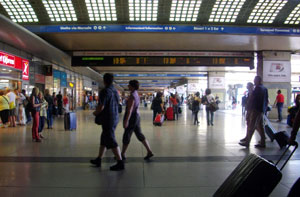 The most nerve wracking event I experienced was when my train was fifteen minutes late. When this occurs, passengers neither know when exactly their train will arrive, nor do they know the platform, or binario, where their train will be located. To make matters worse, I only had a fifteen minute layover between trains in Chiusi Chianciano. Luckily, my delay did not cause me to miss my second train to Siena. After I arrived at the train station, I took a taxi cab to the Residenza San Domenico, the place where students are housed.
The most nerve wracking event I experienced was when my train was fifteen minutes late. When this occurs, passengers neither know when exactly their train will arrive, nor do they know the platform, or binario, where their train will be located. To make matters worse, I only had a fifteen minute layover between trains in Chiusi Chianciano. Luckily, my delay did not cause me to miss my second train to Siena. After I arrived at the train station, I took a taxi cab to the Residenza San Domenico, the place where students are housed.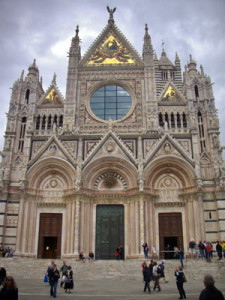 The rooms at Residenza San Domenico are decently furnished. Rooms can house anywhere from two to four students depending on the room. My roommate is a girl from Prescott, Daytona’s sister campus, named Candace. We get along great. No two rooms are alike, but each has a bathroom with a large wardrobe that contains a small kitchenette unit that houses a large sink and hotplate. In addition, silverware, dishes, and cups are provided with the rooms. Some rooms have lofts and others will have large closets and drawers. One of the rooms meant for students has a phenomenal view of neighborhoods across the valley as well as the Duomo, a large gothic church located on of the other hills of Siena.
The rooms at Residenza San Domenico are decently furnished. Rooms can house anywhere from two to four students depending on the room. My roommate is a girl from Prescott, Daytona’s sister campus, named Candace. We get along great. No two rooms are alike, but each has a bathroom with a large wardrobe that contains a small kitchenette unit that houses a large sink and hotplate. In addition, silverware, dishes, and cups are provided with the rooms. Some rooms have lofts and others will have large closets and drawers. One of the rooms meant for students has a phenomenal view of neighborhoods across the valley as well as the Duomo, a large gothic church located on of the other hills of Siena.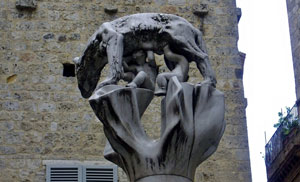 According to the legend, Romulus, the found of Rome, had two sons, Senius and Aschius. It was these two men who founded Siena. Their colors, white and black, are displayed on the flag of the city and in the colors of the Duomo. On one side, there is an outcropping of red brick and a black and white marble wall. According to my professors, the church was supposed to be much larger than it is today. Work on the expansion halted when Siena was struck by the bubonic plague, which killed about two thirds of the population. I walk by the Duomo every day on the way to class.
According to the legend, Romulus, the found of Rome, had two sons, Senius and Aschius. It was these two men who founded Siena. Their colors, white and black, are displayed on the flag of the city and in the colors of the Duomo. On one side, there is an outcropping of red brick and a black and white marble wall. According to my professors, the church was supposed to be much larger than it is today. Work on the expansion halted when Siena was struck by the bubonic plague, which killed about two thirds of the population. I walk by the Duomo every day on the way to class.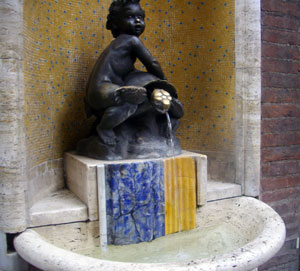 The other class is run by Embry-Riddle. At 9 AM, I take an Italian language class with Massimiliano, an Italian professor. Our learning consists of using a text and workbook along with supplementary lessors. We have learned a lot so far. Typically we have a short 30 minute break at 11AM. This is when most students eat lunch. At 11:30, we either have Massimiliano again or we study Italian culture under Dr. Luca Bonomi, the director of Dante Alighieri. When we have Luca, we usually have a short presentation in class and then he takes us outdoors to walk around and explore Siena. We have visited the Piazza del Campo, which is the city center, as well as the main political buildings. One day, we even analyzed Italian body language and what each of the subtle nuances mean. It was fascinating. After either another session with Massimiliano or Luca, we get another short break of about 15 minutes or so at 1:30 PM. Then we are taught by ERAU professors Dr. Alan Pratt or Dr. Robert Fleck. Dr. Pratt teaches art history, which occurs during the first two weeks of our session. He tries very hard to make sure that we are getting the most out of our studies with daily quizzes that require one word answer and consists of about 15 questions. After Dr. Pratt leaves, we study under Dr. Fleck who teaches Italian contributions to both art and science. Professor Fleck is a high energy teacher. It is quite evident that he is passionate about science. One day, he even tried to draw the solar system on the classroom floor while jumping about in an Einstein t-shirt. He is very entertaining. The end of our day can occur as early as 2:30 PM and as late as 4 PM. It just depends on the day. Luckily, we get three day weekends.
The other class is run by Embry-Riddle. At 9 AM, I take an Italian language class with Massimiliano, an Italian professor. Our learning consists of using a text and workbook along with supplementary lessors. We have learned a lot so far. Typically we have a short 30 minute break at 11AM. This is when most students eat lunch. At 11:30, we either have Massimiliano again or we study Italian culture under Dr. Luca Bonomi, the director of Dante Alighieri. When we have Luca, we usually have a short presentation in class and then he takes us outdoors to walk around and explore Siena. We have visited the Piazza del Campo, which is the city center, as well as the main political buildings. One day, we even analyzed Italian body language and what each of the subtle nuances mean. It was fascinating. After either another session with Massimiliano or Luca, we get another short break of about 15 minutes or so at 1:30 PM. Then we are taught by ERAU professors Dr. Alan Pratt or Dr. Robert Fleck. Dr. Pratt teaches art history, which occurs during the first two weeks of our session. He tries very hard to make sure that we are getting the most out of our studies with daily quizzes that require one word answer and consists of about 15 questions. After Dr. Pratt leaves, we study under Dr. Fleck who teaches Italian contributions to both art and science. Professor Fleck is a high energy teacher. It is quite evident that he is passionate about science. One day, he even tried to draw the solar system on the classroom floor while jumping about in an Einstein t-shirt. He is very entertaining. The end of our day can occur as early as 2:30 PM and as late as 4 PM. It just depends on the day. Luckily, we get three day weekends.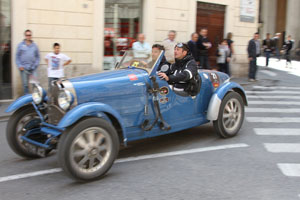 During my first weekend in Siena, while I was walking around with my friend Nathan, I saw an old car race.
During my first weekend in Siena, while I was walking around with my friend Nathan, I saw an old car race.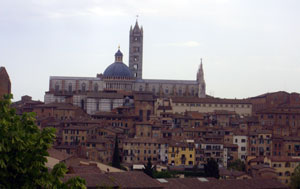
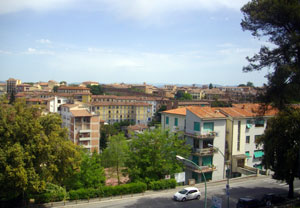
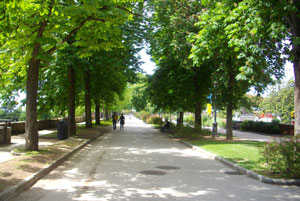
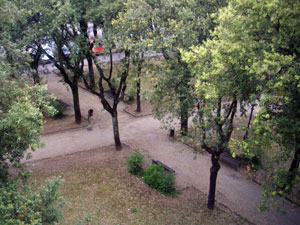
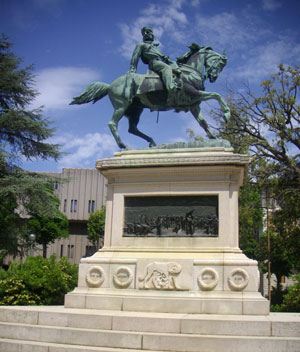
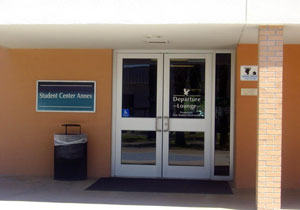 I initially heard of the organization during the fall activities fair that took place near the beginning of first semester. Steven Bohlemann, a student who works in the Study Abroad Office, had a table set up with pictures, posters, and flyers. He was the one who suggested that I look online at the
I initially heard of the organization during the fall activities fair that took place near the beginning of first semester. Steven Bohlemann, a student who works in the Study Abroad Office, had a table set up with pictures, posters, and flyers. He was the one who suggested that I look online at the 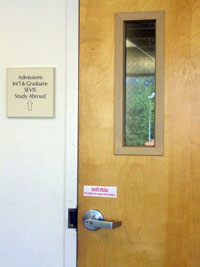 After entering, climb the stairs and look for a plain wooden door almost directly across the room from the staircase. Go through the door and proceed down the hallway until there is a branch to the right that has a sign reading “Study Abroad”.
After entering, climb the stairs and look for a plain wooden door almost directly across the room from the staircase. Go through the door and proceed down the hallway until there is a branch to the right that has a sign reading “Study Abroad”.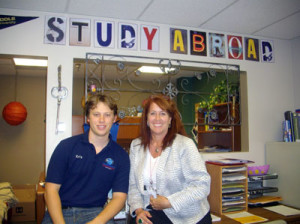 Furthermore, since I am in the Honors Program, Study Abroad also satisfies my HON 350 requirement. I was elated to find out that not only was I able to make my semester course load lighter and more manageable, but studying abroad cost less that attending Summer A on campus at ERAU. I found out this information and other helpful factoids when I attended Study Abroad meetings.
Furthermore, since I am in the Honors Program, Study Abroad also satisfies my HON 350 requirement. I was elated to find out that not only was I able to make my semester course load lighter and more manageable, but studying abroad cost less that attending Summer A on campus at ERAU. I found out this information and other helpful factoids when I attended Study Abroad meetings.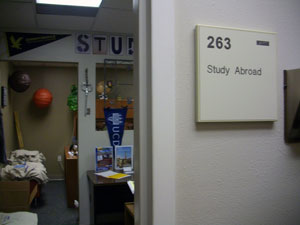 on, I went through my suitcase yet another time to minimize the weight. This will make it easier to travel in Europe, where I will have to haul my own luggage multiple city blocks to get to my destination, Residenza San Domenico. At the end of this week, I will wake up at 4:30am and board an airplane to Houston. The first of three flights to Italy!
on, I went through my suitcase yet another time to minimize the weight. This will make it easier to travel in Europe, where I will have to haul my own luggage multiple city blocks to get to my destination, Residenza San Domenico. At the end of this week, I will wake up at 4:30am and board an airplane to Houston. The first of three flights to Italy!